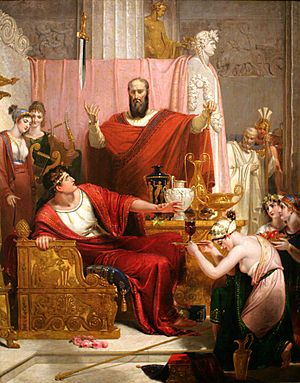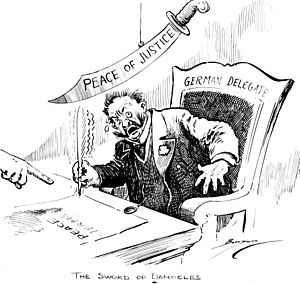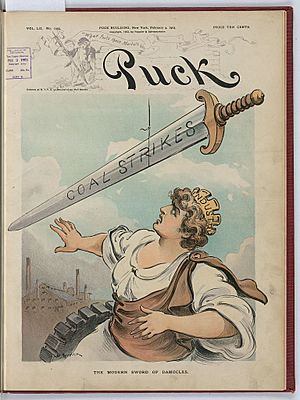Damocles facts for kids
Quick facts for kids DamoclesΔαμοκλῆς |
|
|---|---|

In Richard Westall's Sword of Damocles, 1812, the boys of Cicero's anecdote have been changed to maidens for a neoclassical patron, Thomas Hope.
|
|
| Information | |
| Occupation | Courtier |
Damocles was a person who lived in ancient Greece. He is famous for a story called "the sword of Damocles." This story teaches us about the dangers faced by people in powerful positions.
Damocles was a courtier, which means he was an important helper or advisor to a king. He worked for Dionysius I of Syracuse. Dionysius was a powerful ruler of Syracuse, Sicily, a city in ancient Greece.
The story of Damocles was first written down by a Greek historian named Timaeus. Later, a Roman speaker named Cicero (who lived around 106 to 43 BC) shared the story in his writings. This helped the story become well-known across Europe.
Contents
What Is the Story of the Sword of Damocles?
The story begins with Damocles telling King Dionysius how lucky he was. Damocles thought the king had everything: power, wealth, and a magnificent life.
King Dionysius heard this and offered to switch places with Damocles for one day. Damocles was very excited and quickly agreed. He got to sit on the king's throne.
Damocles was surrounded by amazing luxuries. There were beautiful rugs, sweet-smelling perfumes, and delicious foods. Piles of silver and gold were everywhere. Attendants served him, making him feel like a true king.
But Dionysius had a special surprise. He had made many enemies during his time as king. To show Damocles what it was really like, Dionysius hung a sharp sword above the throne. This sword was held up by only a single hair from a horse's tail.
The sword showed the constant danger and worry a ruler faces. Even with all the riches, a king must always be afraid of dangers. Damocles soon realized that all the luxury didn't matter with the sword hanging over his head. He begged the king to let him leave. He no longer wanted to be so "lucky."
King Dionysius wanted to show that great power often comes with great fear. He had been cruel to gain power, which meant he always had to worry about his enemies. Cicero used this story to show that true happiness comes from being a good person, not from having power or wealth.
How Is the Sword of Damocles Used Today?
The "sword of Damocles" is a common saying. It means that someone in a powerful position is always in danger. It also describes any situation where a bad event could happen at any moment. This danger might be held back by something very small or by chance.
For example, the famous writer William Shakespeare wrote, "Uneasy lies the head that wears a crown." This means that being a king or queen is not easy. There are always worries and dangers.
The Sword in Literature and Art
The story has appeared in many famous works. In The Canterbury Tales by Geoffrey Chaucer, a knight describes a painting. The painting shows a sharp sword hanging by a thin thread over a powerful figure. This shows that even great power can be fragile.

The Roman poet Horace also wrote about the sword of Damocles. He said that a simple life was better than a powerful one. He described how even a great feast would not taste good if a sword hung over your head.
The phrase is also used to describe any situation with a feeling of coming disaster. This is true even if the person isn't powerful. For example, US President John F. Kennedy said the threat of nuclear annihilation was like a sword of Damocles. It hung over everyone in the world.
The sword of Damocles has appeared in many cartoons and illustrations. These often use the image to show dangers in current events or important issues.
The Sword in Popular Culture
You can find references to the sword of Damocles in many modern things. These include novels, movies, TV shows, video games, and music.
- A 1990 video game was called Damocles. In it, players had to stop a comet named Damocles from destroying a planet.
- The song "The Sword of Damocles" is from The Rocky Horror Picture Show.
- An early virtual reality headset from 1968 was called The Sword of Damocles. It was named this because it hung from the ceiling and looked a bit scary.
- In the Canadian TV show Made in Canada (TV series), "Sword of Damacles" was the name of a TV show made by the company in the story.
- In hip hop music, the sword of Damocles is a symbol. It shows the threat that top rappers face of losing their "kingly" position. The group The Fugees mentioned it in their song "Zealots." Kanye West also used the image in his music video for "Power." In the video, a sword hangs over his head.
See also
 In Spanish: Damocles para niños
In Spanish: Damocles para niños
- Croesus and Fate
- Sword of Damocles (Rufus Wainwright song)


